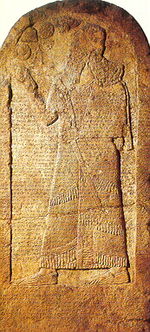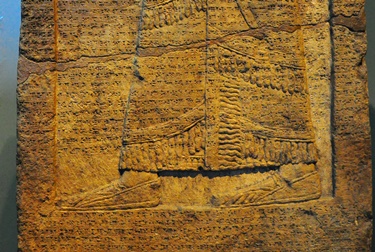Print Article
Author's Bias | Interpretation: conservative | Inclination: covenant | Seminary: Tyndale

The Kurkh Monolith of
Shalmaneser III is
over seven feet tall
© Wikimedia Commons
The Kurkh Monoliths (879-853 BC) are two Assyrian stelae from the reign of Ashurnasirpal II and his son
Shalmaneser III, discovered by John G. Taylor in 1861 at the site of Kurkh (modern Üçtepe, Diyarbakir Turkey)
(1). They are now both on display in the British Museum. Both stelae record the annals of
the kings along with a large relief of the king.
The Shalmaneser III monolith contains a description of the victory (sixth year) of Shalmaneser III at
the battle of Qarqar (also Karkar) on the Orontes River (northern Syria) in 853/854 BC over the Syrian allies
lead by "Adad (ilu IM)-'idri (= Hadadezer) of Damascus, with Ahab of the Northern Kingdom of Israel
(2) and other kings as vassals." (3) A portion of the Annals of Shalmaneser
III reads:
I destroyed, devastated, and set fire to Karkar, his royal city. <Irhulêni> brought
twelve kings to his support; they came against me to offer battle and fight: 1,200 chariots, 1,200 cavalry, and
20,000 soldiers belonging to Hadad-ezer of Damascus; 700 chariots, 700 cavalry, and 10,000 [or 20,000] soldiers
belonging to Irhuleni of Hama; 2,000 chariots, and 10,000 soldiers belonging to Ahab, the Israelite [A-ha-ab-bu
Sir-ila-a-a]; 500 soldiers belonging to the Gueans; 1,000 soldiers belonging to the Musreans; 10 chariots and
10,000 soldiers belonging to the Irkanateans; 200 soldiers belonging to Matinuba'il the Arvadite; 200 soldiers
belonging to the Usanateans; 30 chariots and [ ],000 soldiers belonging to Adunu-ba'il the Shianean; 1,000 camels
belonging to Gindibu' the Arabian; and [ ],000 soldiers [belonging to] Ba'sa, son of Ruhubi, the Ammonite.
Trusting in the exalted might which the lord Assur had given me, in the mighty weapons,
which Nergal, who goes before me, had presented to me, I battled with them. I routed them from Karkar to the city
of Cilzau, killing 14,000 of their soldiers, raining destruction on them like Adad. I scattered their bodies far
and wide, and covered the face of the desolate plain with their vast armies. Using my weapons, I made their blood
to flow down the valleys(?). The plain was too small to let their bodies fall, the wide countryside was used up in
burying them. I spanned the Orontes with their bodies like a bridge(?). In that battle I took from them their
chariots, cavalry, and tamed horses. (4)
The battle of Karkar does not appear in the Old Testament and various explanations have been offered to place
it into the narrative. However, according to the Old Testament, Ahab had overthrown Ben-hadad, the Syrian leader,
who came to lay siege to Samaria, with just 7,000 troops (under the leadership of thirty-two kings,
1 Kings 20:1-34). (5) Ahab's base of operation
for his troops was likely the city of Jezreel. (6) Luckenbill states that popular view, although
he provides his own explanation:
According to the prevailing interpretation of the Hebrew account in the light of the Assyrian
records, the 'two years' truce mentioned in I Kings 22:1 follow
immediately upon the defeat of Benhadad at Aphek, and leave room for Ahab's presence at Karkar. (7)

A close up of the general area where Ahab is mentioned
© Helpmewithbiblestudy.org
But as Luckenbill points out, according to the Assyrian account Ahab was an ally of the king of Damascus.
Wiseman provides a possible explanation:
Aram turned south, perhaps in an attempt to gain new trade routes, since the north had been
cut off by the wars of the Assyrian Ashur-naṣirapli II (883–859 BC) and his successor Shalmaneser III (859–829 BC).
Some think the wars recorded here took place early in Ahab's reign, to allow time for the mellowing of Israel's
relation with Aram when Ahab contributed to the coalition which faced Assyria at the battle of Qarqar in 853 BC
(Bright). Yeivin argues that the first war was early but the second followed after Qarqar, but this is unlikely
in view of 22:1. The aggression of Ben-Hadad II (Hadadezer,
Assyr. Adad-'idri) may have aimed to secure his southern flank while he faced the Assyrian drive to the
Mediterranean c. 888–885 BC. There is no need to view the prophetic allusions as secondary, for their
interpretation of events is consistent with that of the Deuteronomic historian throughout. (8)
The Kurkh stele of Shalmaneser III verifies the historical accuracy of Ahab, king of Israel and the fact that he
had a large army. As Ackerman points out:
The size of Ahab's contribution to the anti-Shalmaneser fighting force at Qarqar indicates, for
example, that Israel was still a major military power in Syria-Palestine at the end of the first half of the ninth
century B.C.E. (9)
Dr. David E. Graves (Ph.D., University of Aberdeen, Scotland) has been
involved in teaching the Bible and archaeology for more than thirty-five years and is currently an
Assistant Professor with Liberty University, Rawlings School of Divinity. He has taught archaeology at Oxford
University, England; provided tours of the Ashmolean and British Museums; traveled extensively in the Middle East;
and been involved in Mount Ararat research. He is currently a supervisor at the Shiloh excavations, Israel and was
part of the team who discovered and excavated the Dead Sea Scroll cave Q12 near Qumran, Israel (Jan 2017) and Tall
el-Hammam (Sodom?), Jordan (2005-2015); and is a member of the Near East Archaeological Society (NEAS). To learn
more about biblical archeaology, visit:
Biblicalarchaeologygraves.blogspot.com.
Ahab, the seventh king of the Israel's Northern Kingdom, was notorious for his marriage to the Phoenician
princess Jezebel. Under her influence, the worship of Baal was given prominence with a temple that included
an image of the Canaanite goddess Asherah, which provoked God more than any other king of Israel
(1 Ki 16:31-34). Ahab, lacking any faith, failed to recognize
the evil influence of Jezebel, and moved to suppress the worship of God by destroying altars and murdering the
prophets of God (1 Ki 18:4, 17-18). It would be the prophet
Elijah who makes a stand to openly oppose Ahab and Jezebel and attest to the real existence of God
(1 Ki 18:20-40).
Footnotes:
1. John George Taylor, "Travels in Kurdistan, with Notices of the Sources of the Eastern and Western Tigris, and Ancient Ruins in Their Neighbourhood," Journal of the Royal Geographical Society of London 35 (1865), 21-58.
2. Gary A. Rendsburg, "Israel Without the Bible," in The Hebrew Bible: New Insights and Scholarship, ed. Frederick E. Greenspahn, Jewish Studies in the Twenty-First Century (New York, N.Y.: New York University Press, 2007), 10; Jonathan M. Golden, Ancient Canaan and Israel: New Perspectives, Understanding Ancient Civilizations (Santa Barbara, Calf.: ABC-CLIO, 2004), 275.
3. Daniel David Luckenbill. "Benhadad and Hadadezer," The American Journal of Semitic Languages and Literatures 27, no. 3 (1911): 267.
4. Daniel David Luckenbill, Ancient Records of Assyria and Babylon: Historical Records of Assyria from Sargon to the End, vol. 2, 2 vols. (Chicago, Ill.: University Of Chicago Press, 1927), 200-252. updated by Alan Humm.
5. Luckenbill, "Benhadad and Hadadezer," 267–83.
6. David Ussishkin, "Jezreel—Where Jezebel Was Thrown to the Dogs," Biblical Archaeology Review 36 no. 4 (July / August 2010), 32-42.
7. Luckenbill. "Benhadad and Hadadezer," 276.
8.Donald J. Wiseman, 1 and 2 Kings: An Introduction and Commentary. Tyndale Old Testament Commentaries 9 (Downers Grove, IL: InterVarsity Press, 1993), 187.
9. Susan Ackerman, "Assyria in the Bible," in Assyrian Reliefs from the Palace of Ashurnasirpal II: A Cultural Biography, ed. Ada Cohen and Steven E. Kangas (Hanover, N.H.: University of New England, 2010), 127. See also Wayne T. Pitard, Ancient Damascus: A Historical Study of the Syrian City-State from Earliest Times Until Its Fall to the Assyrians in 732 B.C.E., New edition (Winona Lake, Ind.: Eisenbrauns, 1987), 128; Ron E. Tappy, The Archaeology of Israelite Samaria, Vol. 2: The Eighth Century BCE, Harvard Semitic Studies 50 (Winona Lake, Ind.: Eisenbrauns, 2007), 509-10.
Copyright ©
2018
Helpmewithbiblestudy.org. All rights to this material are reserved. We encourage you to print the material for personal and
non-profit use or link to this site. If you find this article to be a blessing, please share the link so that it may rise in
search engine rankings.